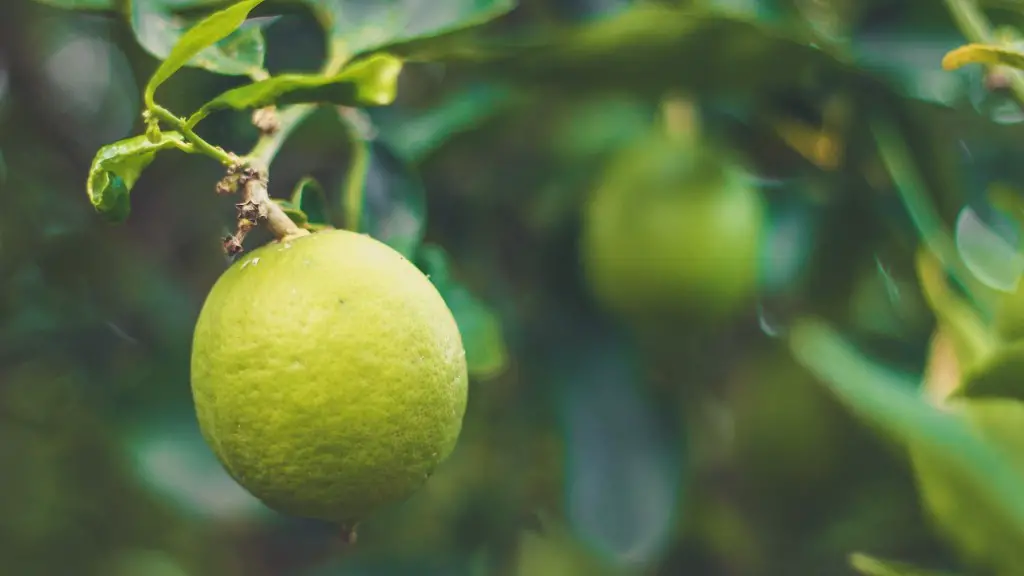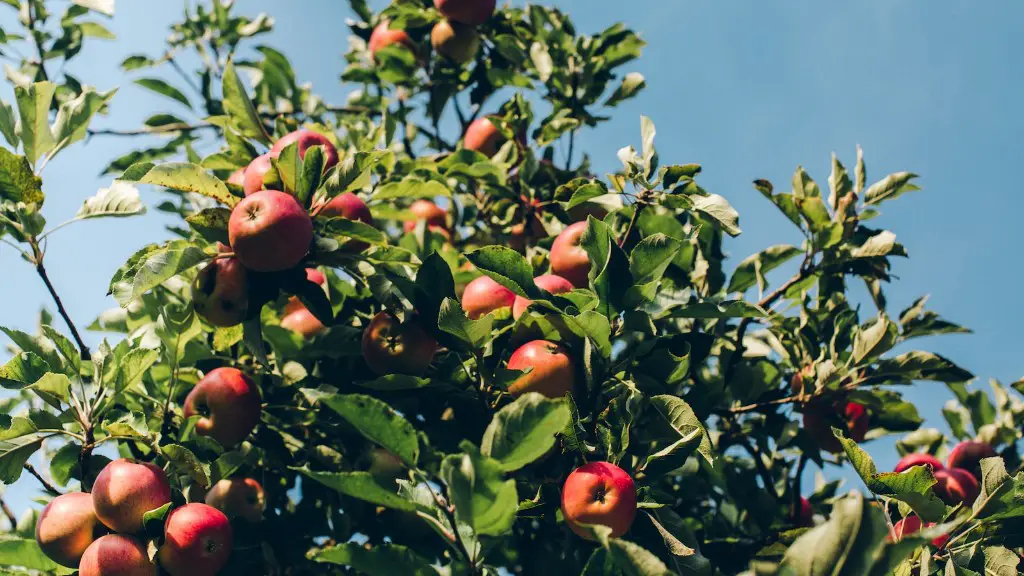All plants need an optimal amount of light, water and nutrients to stay healthy, but the lemon tree has an additional requirement – acidity. Lemon trees are very sensitive to pH levels, and their leaves will turn yellow if the pH of their soil is too high. This is a common problem and can be addressed by adding elements to the soil until it falls into the preferred level.
An acidic soil can also occur if the roots of the tree are exposed to poor drainage or heavy fertilizer, or when roots are planted too deeply. Both can lead to yellowing leaves due to a scarcity of oxygen and too much moisture, resulting in the roots being unable to uptake the nutrition the tree needs. Moreover, if a lemon tree is kept in a too shady environment, the leaves will start to turn yellow since the canopy won’t be receiving enough sunlight, an essential element.
On the other hand, over-watering is one of the main culprits of yellowing leaves. A lemon tree doesn’t necessarily need to be watered every day, but it should be intensely monitored in order to ensure the soil remains moist but not waterlogged. This type of problem means the roots can’t spread to their full extent, resulting in a lack of nutrition and yellowing foliage.
Mites, aphids and other pests may cause yellowing leaves too. The pests can remove the layer of wax which protects the surfaces of the leaves, making them more vulnerable to diseases such as chorosis, an iron deficiency resulting in yellow spots on the foliage.
The levels of nitrogen and magnesium found in the soil can also cause the leaves to turn yellow. A deficiency of these elements will disrupt the absorption of other nutrients which are essential for the vitality and health of the lemon tree. Furthermore, in the event of a fungal infection, salt levels may be elevated, making the plant more vulnerable to mineral deficiencies.
It should, therefore, be noted that a combination of all the above can result in yellowing leaves. A lemon tree needs to be regularly monitored for such problems and the issues must be addressed when spotted. Taking the necessary steps can ensure the tree remains healthy and its leaves vibrant.
Altitude and Irrigation as Factors Affecting Lemon Tree Leaves Turning Yellow
The presence of iron and magnesium in the soil is especially relevant for lemon tree leaves turning yellow, as is the importance of proper irrigation and drainage. If a lemon tree is planted at an exceedingly high altitude, the pH of the soil is likely to be affected and its humidity can increase, resulting in a waterlogged environment. Without air circulation, the roots of the tree can’t uptake the nutrition it needs, causing the leaves to turn yellow.
Another issue is associated with watering practices. Desiccation occurs when the soil dries out one day and it is over saturated the next day. This causes the roots to become weak and incapable of absorbing the nutrients the tree needs. Without the right balance the leaves will start to turn yellow, so it is essential to pay attention to the irrigation process.
Lastly, with proper irrigation and drainage, the pH of the soil can be managed. If the soil is too acidic or too alkaline, the leaves of the lemon tree may start to yellow. Therefore, making use of soil testing kits or pH meters will allow for the acidity of the soil to be monitored and corrected.
Nutrient Deficiencies as Causes of Yellow Leaves in Lemon Trees
Nutrient deficiencies are one of the main factors causing yellow leaves in lemon trees. Obtaining the right nutrients and providing them in the right balance is essential if a lemon tree is to stay healthy. When the tree is short of essential minerals and vitamins, the leaves will start to turn yellow. A soil testing kit will help to determine what minerals the soil is missing.
Calcium and iron are among the most important minerals for lemon trees. Magnesium helps the tree to absorb these elements, thereby allowing for the healthy growth of the foliage. If the iron levels are too low, this will cause a condition known as iron chlorosis which results in weak and yellow leaves. Moreover, if the soil doesn’t contain enough phosphorus, a tree will become stunted and its leaves will turn yellow.
The yellowing of lemon tree leaves can also be caused by a lack of zinc, boron or manganese. Zinc helps to promote the growth of plant cells and without it, the leaves may exhibit stunted growth and become yellow. Similarly, boron helps with the development of new cells while manganese is necessary to allow the tree to absorb nitrogen.
A lemon tree will only remain healthy and its leaves will stay vibrant when supplied with the right nutrients. The right balance of minerals and vitamins must be found and maintained to ensure the tree’s overall health and well-being.
Diseases and Pests as Causes of Yellow Leaves in Lemon Trees
Diseases and pest infestations can lead to the leaves of a lemon tree turning yellow. If a tree is affected by a fungal disease, symptoms such as yellow spots and yellow veins in the leaves may appear. Mites, aphids, thrips, scale and mealybugs are some of the bugs that most commonly target a lemon tree, leaving the leaves dry and yellow as a result.
Diseases and pests can be prevented by keeping the tree healthy and providing optimal conditions. Fertilizers and insecticides must be used moderately according to the instructions given and all foliage should be monitored regularly, especially during the summer months.
The tree should also be inspected to see if there are any yellow and falling leaves. This can be indicative of a flecking and blistering disease which is usually accompanied by gummosis. If discovered, this should be treated as soon as possible in order to prevent it spreading to the healthier parts of the tree.
It is recommended to use natural and organic treatments when dealing with diseases and pests which are threatening a lemon tree. Many of the insecticides and fungicides used to treat such problems contain harsh chemicals, some of which can be hazardous and damaging to nature over prolonged periods.
For this reason, it is important to practice appropriate horticultural techniques such as intercropping and crop rotation in order to keep the soil healthy and the tree strong. This will not only help prevent diseases and pests, but it will also give the tree the best chance of avoiding yellowing leaves.
Soil Quality and Stress as Contributing Factors to Yellow Leaves in Lemon Trees
The quality of the soil and certain types of stress can contribute to yellow leaves in lemon trees. If a tree is planted in a overly compacted soil with no nutrients and dries out very quickly, this will lead to yellowing of the foliage. Similarly, soils that remain saturated for long periods of time can eventually allow for rods roots and will lead to yellow leaves.
Fluctuating temperatures and strong winds can also cause yellowing leaves as they can both be very damaging to the tree. If a tree receives too much sunlight or a draught of cold air during the winter months, yellowing can occur due to sunburn or the shock of cold. Such stress should be avoided at all costs.
Likewise, planting a lemon tree too close to a larger tree which is generating considerable shade is likely to cause yellow leaves. Very large trees have a tendency to



